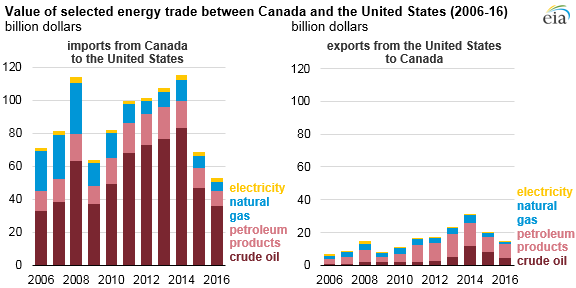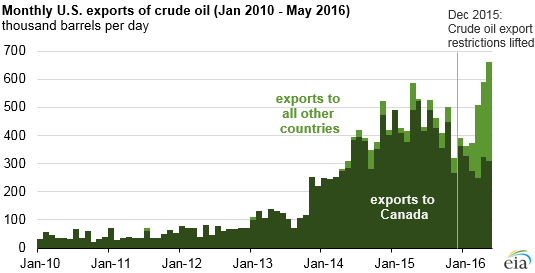U.S. imported $53 billion in energy from Canada in 2016
The EIA outlined the United States’ energy trade with Canada in a note today, profiling the U.S.’s primary energy trade relationship. According to the Census Bureau, energy accounted for about 5% of the value of all U.S. exports to Canada and more than 19% of the value of all U.S. imports from Canada in 2016. For 2016, the value of U.S. energy imports from Canada was $53 billion, while the value of U.S. energy exports to Canada was $14 billion.
The majority of U.S. energy imports from Canada are in the form of crude oil, according to the EIA. Canada is by far the largest source of U.S. crude oil imports, providing 41% of total U.S. crude oil imports in 2016. The volume of crude imports has increased since 2014, from around 90 MMBBL/month to around 110 MMBBL/month. The value of these imports has decreased, however, from $83 billion in 2014 to $36 billion in 2016.
Virtually all U.S. crude oil exports went to Canada until the export ban was lifted in 2013. Since this time the U.S. has significantly increased exports to other countries. Canada remains the primary export destination, though, receiving 58% of U.S. crude oil exports in 2016.
The trade in petroleum products between the two nations is relatively balanced, with imported and exported values and volumes similar. The specific products exported and imported by the U.S. is quite different, though. The U.S. imports primarily gasoline from eastern Canada for markets in the northeast. Little of the United States’ exports to Canada are gasoline, instead pentanes plus, LPG and other oils dominate.
The vast majority of U.S. natural gas imports, 97%, come from Canada. The U.S. imported 8 Bcf/d in 2016, according to the EIA. Western Canadian gas is transported via pipeline to the West, Midwest, and Northeast. The U.S. does export some natural gas to Canada, mostly to Ontario and Quebec, but only about 2 Bcf/d in 2016.
The rise of the Marcellus and Utica, though, has had a significant effect on the U.S. natural gas trade balance. The northeast states are much less dependent on Canadian gas, and may export increased volumes in the future.



